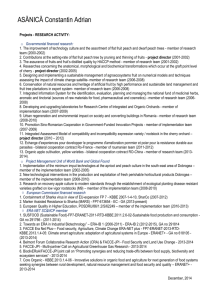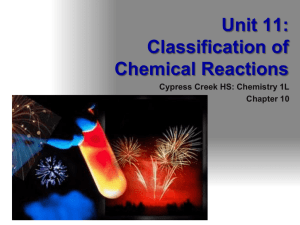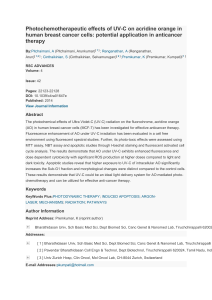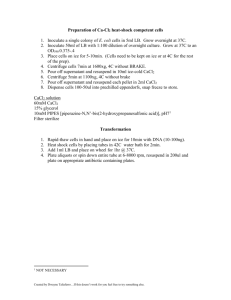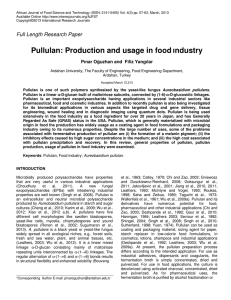African Journal of Food Science and Technology (ISSN: 2141-5455) Vol.... DOI: http:/dx.doi.org/10.14303/ajfst.2016.012
advertisement
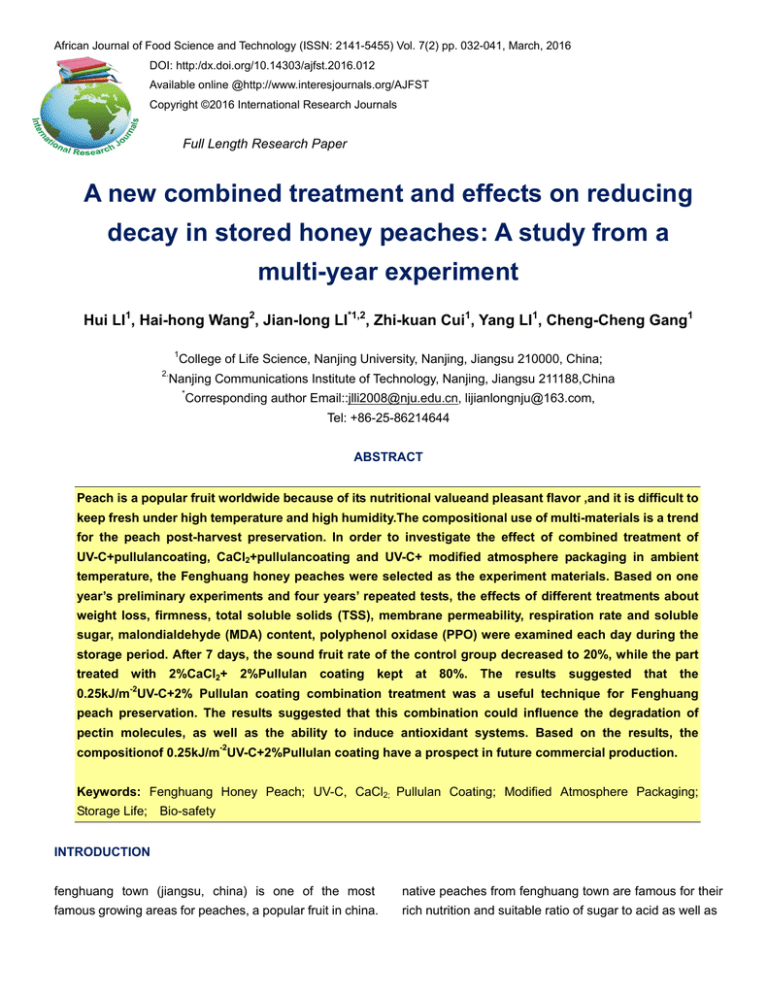
African Journal of Food Science and Technology (ISSN: 2141-5455) Vol. 7(2) pp. 032-041, March, 2016 DOI: http:/dx.doi.org/10.14303/ajfst.2016.012 Available online @http://www.interesjournals.org/AJFST Copyright ©2016 International Research Journals Full Length Research Paper A new combined treatment and effects on reducing decay in stored honey peaches: A study from a multi-year experiment Hui LI1, Hai-hong Wang2, Jian-long LI*1,2, Zhi-kuan Cui1, Yang LI1, Cheng-Cheng Gang1 1 College of Life Science, Nanjing University, Nanjing, Jiangsu 210000, China; 2. Nanjing Communications Institute of Technology, Nanjing, Jiangsu 211188,China * Corresponding author Email::jlli2008@nju.edu.cn, lijianlongnju@163.com, Tel: +86-25-86214644 ABSTRACT Peach is a popular fruit worldwide because of its nutritional valueand pleasant flavor ,and it is difficult to keep fresh under high temperature and high humidity.The compositional use of multi-materials is a trend for the peach post-harvest preservation. In order to investigate the effect of combined treatment of UV-C+pullulancoating, CaCl2+pullulancoating and UV-C+ modified atmosphere packaging in ambient temperature, the Fenghuang honey peaches were selected as the experiment materials. Based on one year’s preliminary experiments and four years’ repeated tests, the effects of different treatments about weight loss, firmness, total soluble solids (TSS), membrane permeability, respiration rate and soluble sugar, malondialdehyde (MDA) content, polyphenol oxidase (PPO) were examined each day during the storage period. After 7 days, the sound fruit rate of the control group decreased to 20%, while the part treated with 2%CaCl2+ 2%Pullulan coating kept at 80%. The results suggested that the -2 0.25kJ/m UV-C+2% Pullulan coating combination treatment was a useful technique for Fenghuang peach preservation. The results suggested that this combination could influence the degradation of pectin molecules, as well as the ability to induce antioxidant systems. Based on the results, the compositionof 0.25kJ/m-2UV-C+2%Pullulan coating have a prospect in future commercial production. Keywords: Fenghuang Honey Peach; UV-C, CaCl2; Pullulan Coating; Modified Atmosphere Packaging; Storage Life; Bio-safety INTRODUCTION fenghuang town (jiangsu, china) is one of the most native peaches from fenghuang town are famous for their famous growing areas for peaches, a popular fruit in china. rich nutrition and suitable ratio of sugar to acid as well as Hui et al., 033 their strong flavor. however, peaches have a very short to enhance the storage life of pepper (vicente et al., 2005), shelf life of less than 3 days at ambient temperature due tomato (barkaet al., 2000), citrus fruits (ben-yehoshua et to their rapid metabolism after harvest(akhtaret al., 2010; al., 1992), grapefruit (d’hallewin et al., 2000), zucchini asgharia and aghdam, 2010). this is due to their higher squash (erkan et al., 2000) mainly by fungal decaying and respiration rate and high susceptibility to chilling injury keeping firmer (vicente et al., 2005), delaying the cell wall and fungal decay (robertson et al., 1990). their shelf life is degradation and retarding softening of the fruits tissues limited by weight loss and physiological disorders, as well (barka et al.,2000),inducing the appearance of phyto- as internal browning and changes in texture (fishman et malexins (d’hallewin et al., 2000).Modified atmosphere al., 1993). therefore, cold storage has always been used packaging is an alternative way to package respiring as the main method to slow these processes to delay the products, respiring products must have O2 to produce peaches decay, but chilling injury (ci) limits its peach enough energy to maintain their integrity and quality storage life at low temperatures, such as apples (lurie et through the process of aerobic respiration, in which al., 1994), mango (ketsa et al., 1998), and strawberry carbohydrates are converted to co2 and water at the (garcia et al., 1995). But for consumers' increasing expense of O2(gorrisetal.,1992). post-harvest application awareness of health and environment consideration, of map was reported to enhance the shelf-life of suli pear alternative solutionsto control browning that meet food (jiang et al., 2011),european plum (zhanget al., 2005) safety policy and easy topromote are needed.the single mainly by decreasing the rates of respiration and ethylene treatments of calcium chloride (cacl2), ultraviolet(uv-c), production (jiang et al., 2011), restraining decline of pullulan film and map have been extensively studied for deoxidized sugar and reducing weightlessness and rotting commercial applications (li et al., 2009; luoet al., 2011; of fruits (zhang et al., 2005).Pullulan is a polysaccharide manganaris et al., 2007).Calcium affects fruit quality and polymer consisting of maltotriose units, also known preservation by playing a fundamental role in maintaining asα-1,4(6)-glucan(fujii and shinohare 1986; kimoto et al. the stabilization of cell wall (vicente et al., 2005). the 1997). pullulan films are prepared by drying a pullulan post-harvest application of cacl2 was also reported to solution on a smooth surface and it can be as thin as enhance the storage life of apricots (antunes et al., 2003), 5-60um peaches (manganaris et al., 2007) and strawberries characterize the physiological and biochemical responses (verdini et al., 2008), mainly by reducing pectin solubility (i. of the 'fenghuang' honey peaches to 0.25kj/muv-c+2% lara et al., 2004), strengthening cell wall(vicente et al., pullulan coating ,2% cacl2 + 2% pullulan coating, 2007), delaying fruit ripening and decreasing decay rate(i. 0.25kj/muv-c+ modified atmosphere packaging in mixed lara et al., 2004) and maintaining firmness (manganaris et treatments.based on 1 year`s preliminary study and al.,2007). the appropriate use of cacl2 can close the 4-year continuous tests, the effects of treatments on passage of ca2+ in the cell membrane stable cell wall and weight loss rate, firmness, soluble solids content (ssc), cell membrane (mo and wang, 1994). ultraviolet light has electrolyte mainly been used for surface disinfestation (el-gaouth and malondialde-hyde(mda)content, wilson, 1995). the effect of ultraviolet light (uv-c, λ=254nm) polyphenol oxidase (PPO) were examined each day could beattributed to two underling mechanisms. first, during 7 days ambient temperature storage(25±1°c) so as there is the direct effect on the pathogens because of dna to evaluate its potential use for browning control and damage. second, uv-c can induce resistance mechanisms quality maintenance of peach fruits, in addition, fruit in different fruits against pathogens (liu et al., 1993; quality was evaluated from a consumer perspective. this nigroet al., 1998). uv-c was used for harvested fruits in study was also to determine the impact of this three controlling microbial activity and deterioration (erkanet al., combined methods on fruit quality during the storage 2001). post-harvest application of uv-c was also reported period of ‘fenghuang’ honey peach and intended to serve (yuen 1974).Our research leakage, target soluble respiration is to sugar, rate and 034 Afr. J. Food Sci. Technol. as a practical guideline for fruit producers and consumers 90-95% RH. After treatment, fruit were transferred to as well. 25±1°C for 7 days storage. A fruit sample from each condition was removed for ripening assessment (three replicates of six peaches each) every day. The same fruit MATERIALS AND METHODS used for ripening measurements was used for the sensory Material and pretreatments panels. The “Fenghuang” water peach in Zhangjiagang City is the Mass loss, fruit firmness and TSS earliest cultivated peach in the southern China with more than 100 years' history. The subtropical humid monsoon The mass was measured by an MP2000-2 balance climate with four distinct seasons and sufficient light (±0.05g) (Shanghai Balance Instruments, China). Mass provide a suitable natural condition for peaches growing. loss was calculated as: mass loss = Wi being the initial The annual average temperature is about 15.7°C and sample weight and Wf the final sample weight. Results total are reported as percentage weight loss. rainfall 1167mm, and the deep and loose yellow–brown soil in this area is rich of soil organic matter. The firmness of peaches was recorded during storage The tree of “Fenghuang” water peach is about 2-3 meters to determine the shelf life. Firmness values of each high with wide and deep root system. Most of fruits individual peach without skin were measured at three ripened in mid-late July and August with about 105 days points of the equatorial region by using GY-3 firmness growth period, the average weight of fruit is 250 grams. tester (Zhejiang Tuopu, China) with an 11 mm diameter Peaches (Prunuspersica Batsch cv. Fenghuang) were flat probe. The firmness of each peach was measured hand-harvested towards the end of the commercial three times on different sides. Three replicates were used harvest from a commercial orchard in Nanjing, China. per treatment and the result is the mean of the replicates. Fruits were transported to the experimental laboratory at Measurement of TSS was conducted on juice samples the Nanjing University on the same day and were selected collected for uniform size, color and absence of mechanical Refractometer (WZS-I, Shanghai Optical Instruments, damage after excluding the ones inappropriately matured China) and expressed as Brix. from five fruits per treatment, using a and with defects. 2%CaCl2 solution0.25kJ/m-2UV-C, 2%Pullulan coating, 0.02mm MAP bag were chosen as Membrane integrity the optimal concentration for our experiment based on 1 year preliminary experiments and numerous repeated Membrane permeability, expressed by relative electrolyte tests. Peaches were divided into four lots, part one was leakage rate, was determined using a conductivity meter control group, part two was irradiated with 25W UV-C (Model DDS-11A, Shanghai Scientific Instruments, China). lights(The peaches were placed individually on opposite Determination of membrane integrity was carried out rotating rods, -25cm from the irradiation source, and according to a modified method of Jiang et al (Jiang YM. turned continuously during UV-C treatment to provide and Chen F., 1995). These were then incubated at 25°C uniform irradiation over the whole fruit surface) for 3 for 180min. The resulting solution was then placed in a minutes and then coated with 2% Pullulan solution for 3 water bath (100°C) for 30min and cooled to 25°C before minutes, after that then air dried for 3 hours; part three the final conductivity (total electrolyte leakage) was was treated with 2%CaCl2 + 2%Pullulan mix solution for 3 measured. minutes then air dried for 3 hours and the last lot were The percentage membrane integrity was calculated as: irradiated with 25W UV-C lightsfor 3 minutes and then Membrane integrity% =[1-(electrolyte leakage after 180 packaged min submersion/total electrolyte leakage)] × 100. with MAP. All treatments were applied at Hui et al., 035 Rate of respiration Data processing and statistical design Respiration was measured by the rate of CO2 production. For each combined treatment, the experiment was In doing this 30 fruits (ten fruit per chamber) from each conducted as a completely randomized design with all the treatment were sealed in a chamber and air was passed treatments. All statistical analyses were performed with through the chamber. The effluent air was connected to a SPSS (SPSS Inc., Chicago, IL, USA) and Microsoft Excel. GXH-3051 (Institute of Junfang Scientific Instrument; Data were analyzed by one-way analysis of variance Beijing, China) Infrared Gas Analyser (IRGA) and the (ANOVA). Mean separations were performed by Duncan's respiration rates was expressed as mg•h−1•kg−1. Three multiple range tests. Where significant differences were independent replicates were conducted under each detected, mean comparisons were done by the L.S.D. test treatment. (P<0.05). Soluble sugar and membrane oxidation RESULTSAND ANALYSIS MDA concentration was measured according to Dhindsa Figure1. (Dhindsa RS et al., 1981) with modification. This involved 2%CaCl2+2%Pul, 0.25kJ/m-2 UV-C+ MAP treatment after grinding of tissue samples (2.0g) in liquid nitrogen and an harvest on weight loss rate (A), firmness (B), soluble extract was obtained in 5 mL 10% (w/v) trichloroacetic solids acid (TCA). After centrifugation at 10,000 ×g for 15 min, 2 malondialdehyde content (E), respiration rate (F) and mL aliquot of the supernatant was mixed with 2mL 10% polyphenol oxidase (PPO)(G) of ‘Fenghuang’ peach fruit (w/v) TCA containing 0.6% (w/v) thiobarbituric acid (TBA). at the end of 7 days ambient temperature storage. Bars The mixture was heated to 100°C for 20 min, quickly represent the standard errors of the means of triplicate cooled and centrifuged at 10,000 x g for 10 min. The assays. Effects content of (C), 0.25kJ/m-2UV-C+2%Pul, electrolyte leakage (D), supernatant was collected and absorbances at 532,600 and 450 nm were then measured in spectrophotometer Effects of UV-C+Pul, Pul+CaCl2 and UV-C+MAP on (Shanghai Jinghua, 756MC). The MDA concentration was weight loss rate during storage calculated according to the formulaand the soluble sugar =11.71 * A450.Three independent replicates were conducted in each treatment. As shown in Figure1A, the weight loss rate of fruit treated with CaCl2+Pul reduced by 1.384% after 7 days of storage and was the lowest compared to the others (Figure1). The CK set recorded maximum weight loss rate Determination of the PPO activity of 3.232%. The other two combined methods (i.e., To measure PPO activities, 2-g tissue each from 10 fruits 0.25kJ/m-2UV-C+2%Pullulan was homogenized in 5 ml of 0.1 M phosphate buffer (pH 0.25kJ/m-2UV-C+modified 6.4) after showed the maximum weight loss rate of 1.534% and centrifugation (10,000 rpm 15 min at 4 °C), as enzyme 1.978% after 7 days of ambient temperature. There was extracts. The increase in absorbance at 410 nm against no significance difference among all the treatments blank (prepared in the absence of enzyme) was (P>0.05),while there were significance difference between automatically recorded at every 30 sec up to 3 min, using the CK and all treatments (P < 0.05). Calcium ions a spectrophotometer (756MC). One unit (u) of enzyme increase activity was defined as the amount that caused a change non-sterifiedpectins. of 0.001 in absorbance per minute. permeable to water, reduced disassembly of this structure and the supernatant was collected, the stability coating atmosphere of Although cell walls plant cell and packaging) by binding walls are Afr. J. Food Sci. Technol. Weight loss rate/% A 20 CK UV‐C+Pul UV‐C+MAP CaCl2+Pul B 9 8 15 7 Firmness/kg•cm‐2 036 10 5 CK UV‐C+Pul UV‐C+MAP CaCl2+Pul 6 5 4 3 2 1 0 0 0 1 2 3 4 5 6 0 7 1 2 3 4 5 6 7 Storage days/d Storage days /d might result in a higher resistance to water flux. Similarly, combined treatment effectively reduced the firmness by Navjot et al (Navjot et al., 2010) found that a dip of 6% 32.7%, 50.2% and 39.3% throughout the storage period CaCl2 proved very effective in reducing loss in weight of separately. It was shown that combined of CaCl2 and Pul “Earli Grande” peach over control. Schirraet al (Schirra et treatment was more effective than the application of either al., 1997) demonstrated that 2% CaCl2 treatment treatment. It was indicated that the softening of fruit decreased the rate of fruit weight loss during simulated texture had a close relationship with the deploymerisation marketing period; On the other hand, Pullulan solution and films have excellent mechanical properties and the ability Reasonable contents of calcium can retain high levels of of oxygen resistance, which couldeffectively protect the ionically-bound pectins and retard the textural degradation fruits from transpiration. (Vicente et al., 2007). Previous studies showed that solubility of flesh cell wall polysaccharides. Ca2+-treated fruits exhibited higher values of flesh Effects of UV-C+Pul, Pul+CaCl2 and UV-C+MAP on firmness during storage (Akhtar et al., 2010; Manganaris fruit firmness et al., 2007) and GA3 significantly affected (p < 0.05) the fruit firmness of '0900 Ziraat' sweet cherry cultivar(Li et al., Fruit firmness is an important indicator of postharvest 2009). physiology and quality of fruits during storage. The major changes of softening in peaches involved the catabolism Effects of UV-C+Pul, Pul+CaCl2 and UV-C+MAP on of cell walls and the development of an intercellular matrix soluble solids contents (SSC) containing pectins (Harker and Maindonald 1994). Fruit firmness decreased gradually during storage most likely Soluble solids content (SSC) is an important parameter due to hydrolysis of metabolites. Higher firmness (4.56 for fruit quality evaluation during the storage periods. 2 kg/cm ) was observed in fruits treated with 2% CaCl2+Pul Sugars are the main soluble metabolites, and include after 7 days storage whereas minimum firmness was glucose, fructose and sucrose comprising 99% of total under control after same storage period (Figure1B). The sugar content. Figure1C shows the results of different experimental results showed that the firmness of control combined treatments on soluble solids contents (SSC), 2 with an initial firmness of 7 kg/cm decreased to 1.97 indicating that treatment with 2% CaCl2+Pulwas most kg/cm2 after 7 days storage, while the firmness of effective (p<0.05) in maintaining the SSC than other 0.25kJ/m-2UV-C+2%Pullulan coating treatment was 3.61 treatments. The SSC of fruits treated with UV-C +Pul 2 kg/cm and 0.25kJ/m-2UV-C+ modified atmosphere 2 packaging treatment was 3.95 kg/cm . Those three (p<0.05), UV-C + MAP reduced to 9.39%, 10.94%, while control grope recorded to 8.05% after 7d storage. It was Hui et al., 037 indicated that 2% CaCl2+Pul treatment was more effective (Manganaris et al., 2007). Based on the treatment of 2% in maintaining the SSC than other treatments. It is CaCl2+Pul the cell wall of honey peach becomes more possible that high CO2 concentrations inside packages strengthened which limits the rise in electrolyte leakage activated hydrolysis and glycolysis that resulted in effectively, suggesting greater membrane integrity. Similar consumption of sugars (Bodelón et al., 2010). Similar effect of CaCl2 on fruit quality was also reported by findings that CaCl2 inhibited the decrease of soluble solid Antunes in fresh-cut kiwifruit (Antunes et al., 2010). content of Fraiar plum fruit is reported by Zhang et al., ((Zhang et al., 2009). Effects of UV-C+Pul, Pul+CaCl2 and UV-C+MAP on respiration rate Effects of UV-C+Pul, Pul+CaCl2 and UV-C+MAP on electrolyte leakage Respiration is a major factor contributing to postharvest loss, as it converts stored sugar to energy in the presence Electrolyte leakage, which is a measure of loss of of an oxygen substrate, leading to premature senescence semi-permeability of cell membranes, can be used as an (Amnon et al., 1998). The rate of CO2 production of indicator of membrane damage; it is also widely used as control fruit increased quickly and reached a maximum an indicator of chilling injury (Zhang et al., 2011). As value on 2th day and decreased for a while, and in the last shown in Figure.1D, electrolyte leakage increased during 4 days it kept a rising trend. (Figure 1E).The respiration the 7 days storage. Fruit treated with 2% CaCl2+Pul rate of fruits treated with those three combined treatment treatment was most effective in inhibiting the leakage reached their peaks at 96.92mg• (kg•h)-1, 103.845 mg• (kg increase, increasing to 13.53% on the 7th day of storage, •h)-1 and 83.36 mg• (kg•h)-1 separately. The respiration while the control was 21.23% (P<0.05).The electrolyte rate of 2% CaCl2+Pul treatment fruit was considerably leakage of fruits treated with 0.25kJ/m-2UV-C+2%Pullulan lower(P <0.05) than that in control fruit, indicating that 2% coating and 0.25kJ/m-2UV-C+modified atmosphere packa CaCl2+Pul treatment inhibited most effectively. These -geing were recorded 15.85% and 16.54%. It was results demonstrated that 2% CaCl2+Pul treatment reported that calcium plays an important role in the suppressed the rate of respiration production. It has been stabilization of cell membranes, as fruits softened more demonstrated that CaCl2 markedly inhibited ethylene with the increase in free calcium in flesh fruits production and respiration rate in Qinwang peach (Yu et 038 Afr. J. Food Sci. Technol. al., 2004) during storage and 'Hongjiang' orange at alleviated by three combined treatment. This suppression ambient temperature (Xia et al., 2009). in MDA content by CaCl2 treatment has also been reported by Xia (Xia et al., 2009). Effects of UV-C+Pul, Pul+CaCl2 and UV-C+MAP on MDA Effects of UV-C+Pul, Pul+CaCl2 and UV-C+MAP on PPO Long time storage can alter the structure of the membranes due to lipid peroxidation. MDA, a secondary The major concern with regard to quality deterioration of end product of polyunsaturated fatty acid oxidation, is peach fruits is flesh browning, which is associated with thus widely used as an indicator of lipid peroxidation. phenol-related metabolic enzymes POD and PPO (Loaiza Changes in MDA levels in a tissue can be a good indicator –Vealarde and Saltveit, 2001). PPO is a key enzyme for of the structural integrity of the membranes of plants enzymatic browning in many fruits. The latent form of subjected to decrepit. As shown in Figure 1F, MDA PPO is often activated during ripening, senescence or content of control increased gradually within 7 days stress condition when the membrane is damaged, which storage. Highest MDA (2.74 µmol•L-1) was observed in results in an increase of PPO activity (Mayer, 1987). As control fruits after 7 days of storage and minimum shown in Figure.1G, PPO activity decreased inconstantly MDA(p<0.05) (1.51µmol•L-1) was observed under three during the storage period. It has also been demonstrated combined treatment after same period. At the end of that three combined treatment can inhibit PPO effectively, storage, MDA content in treated fruit was nearly 45% that PPO had a sudden increase over the first 2 days, lower than that in control fruit. These data clearly indicate reached the first peak, then it decreased on the third day, that damage caused by high temperature stress could be after that. it will increased gradually and reached Hui et al., 039 maximum values on the 7th day, showing about a 118% CaCl2 treatment has also been reported by Xia et al., (Xia increase. with et al., 2009). There was a progressive increase in the and respiration PPO in the fruits 0.25kJ/m-2UV-C+2%Pullulan 0.25kJ/m-2UV-C+modified treated coating atmosphere packaging rate of storage(107.89mg*kg-1*h-1). fruits The lowest during PPO was increased within 2 days and lowered down afterwards. recorded by in fruits(408.7Ug-1) treated by UV-C+Pul This change may be related to the stress at the first 2 during days of storage, and the inhibition effect appeared later on. concentration of organic solutes as a consequence of The recorded of 0.25kJ/m-2UV-C+2%Pullulan coating water loss, UV-C treatment caused inactivation of was the lowest 408.7U/g. Meanwhile, the PPO activities hydrolyzing enzymes responsible for conversion of starch of all treatments were lower than that of the control. into sugars. From the skin color, flesh color, aroma and markedly flavor we found that there are better than the control, and inhibited the activities of polyphenol oxidase of Qinwang there is a significant different between the treated and the peach (Yu et al., 2004), Pul coating treatment delayed control group. Under current dose, no negative influence activities of PPO of 'Yinhualu' honey peach (Dong et al., of UV-C treatment on fruit quality or fungal development 2011)(Dong et al., 2011). on peaches could be found, external damage of fruit due Previous work demonstrated that CaCl2 storage might be due to an increased to ultraviolet exposure, such as peel browning or DISCUSSIONS off-flavors. Mechanism analysis of different treatments on Security analysis of the treatments on Fenghuang Fenghuang honey peach honey peach The weight lossrate of fruit treated with 2% CaCl2 + Pul Calcium is an important element to build up creature body, ranged from 0 to 1.38% during 7 days of storage and was in agricultural production this element is often used as lowest compared to others (Figure1A). The control fruits fertilizer, so it clearly safe to human and animals. The recorded maximum.Fruit firmness decreased gradually effect of ultraviolet light (UV-C, λ=254nm) can be during storage, but the rate of decrease in firmness was explained in two ways. First, there is the direct effect on slower in 2% CaCl2+Pul treated fruits (Figure1B), that may the pathogens because of DNA damage. Second, UV-C because the calcium have the ability to stable the can induce resistance mechanisms in different fruits membrane and cell walls’ structure strongly, help to against pathogens. It is well known that plant tissues maintain the firmness of flesh, and at the same time produce increased amount of phytohormone when calcium and pullulan may decrease the activity of subjected to various biotic and abiotic stresses. Exposure cellulose pectinase. The fruits treated with 2% CaCl2+Pul to UV-C irradiation has been shown to induce resistance retained higher (p≤0.05). SSC of 2% CaCl2+Pul treated against pathogens in a number of species. At the same group decreased throughout the storage period as time,we can see that the ultraviolet light works in a compared to control. Those two factors make the result physical way and meet the food safety requirements that 2% CaCl2+Pul is better than the others. Long time well.We use the MAP package to provide an isolated storage can alter the structure of the membranes due to circumstance with low level of O2 or high slevel of CO2 to lipid peroxidation. The MDA levels after Pul+CaCl2 inhibit the intensity of aerobic respiration. Meanwhile the treatment increased slowly (1.69 μmol•L-1) compared MAP materials we used were stable enough to keep in with other treatments during storage. At the end of storage, good condition and safe to human and animals.Pullulan is MDA content in treated fruit was nearly 45% lower than non-toxic, non-mutagenic, odorless, tasteless, and edible that in control fruit. This suppression in MDA content by (Fujii and shinohare 1986; Kimoto et al. 1997). For it 040 Afr. J. Food Sci. Technol. non-toxic, non-mutagenic, odorless, tasteless, and edible, CAF2015-RR14-NMY-Odeh ) , the Jiangsu Province it is safe in the food industry. Agricultural Three Renovations Project of China (SXGC [2014]287) and the nutrition physiology, decay mechanism and comprehensive preservation research of CONCLUSIONS Fenghuang water peach in Zhangjiagang City (ZKN1002). First, similar to previous studies, we found that the mixture applications of UV-C+Pul, CaCl2+Pul and UV-C+MAP REFERENCES could alleviate high temperature injury and prolong the storage life of peach fruit. This suggested that the mixture Akhtar A, Abbasi NA, Hussain A(2010)Effect of calcium chloride treatments activate higher temperature stress defensive treatments on quality characteristics of loquat fruit during storage. capacity. All the results here indicated that the combined Pakistan Journal of Botany.42(1):181-188. treatment might alleviate oxidative stress in peach fruit. Amnon L, Weibo J, Ella L, Nehemia A(1998).Gibberellic acid and CO2 Second, the combination of CaCl2+Pullulan treatment enhanced most of the indicators which might be attributed additive effect in retarding postharvest senescence of parsley. J. Food Sci. (63):66-68. to its ability to enhance defense systems against high Antunes MDC, Correia MP, Miguel, M. G., Martins, M. A. and Neves, M. temperature stress and pathogen, induce antioxidant A..The effect of calcium chloride postharvest application on fruit systems, affect the levels of polyamines and provide an storage ability and quality of 'Beliana' and 'Lindo' apricot isolated environment.The combined treatment could (Prunusarmeniaca result in a significant enhanced control of blue mold rot in cultivars.ActaHorticulturae.2003 ,(604):721-726. L.) peach fruit, which suggested that the two treatments in Ben-Yehoshua S, Rodov V, Kim JJ, Carmeli S(1992) Preformed and combination activate more defensive capacity against induced antifungal materials of citrus in relation to the enhancement blue mold in peach fruit. of decay resistance by heat and ultraviolet treatments. J. Agric. Food Finally, the results of this work support the use of UV-C+ Pul, CaCl2+Pul and UV-C+MAP treatment as a Chem.(40):1217–1221. Bodelón OG, Blanch M, Sanchez-Ballesta MT, Escribano MI, Merodio possible strategy to alleviate the softening and protect the C(2010) The effects of high CO2 levels on anthocyanin composition, peaches from pathogen effectively and prolong the antioxidant activity and soluble sugar content of strawberries stored storage life. Due to its easy availability and operation, at low non-freezing temperature. Food Chemistry,122(3):673-678. meet the food safety policy and no harm to environment, Dhindsa RS, Dhindsa PP, TA T(1981)Leaf senescence: Correlated with 2% CaCl2 +Pullulan coating treatment could be a reliable increased levels membrane permeability and lipid peroxidation and solution to control postharvest decay of peach fruit and decreased levels of SOD and CAT. Journal of Experimental much more suitable for promotion in the farmers. All these Botany(32):93-101. results suggested CaCl2+Pullulan that coating the may combination have of 2% Dong Y, Tong QY(2009).Effect of different coating treatments on peach potential for quality during cold storage. Science and Technology of Food comercialization. Industry,30(06):320-329. El-Gaouth A, Wilson CL(1995).Biologically-based tech-nologies for the ACKNOWLEDGEMENT control of postharvest diseases.Postharvest News Inf.,6(1):5–11. Erkan M,Wang CY, Krizek DT(2001).UV-C irradiation reduces microbial We are grateful to the chief editor and anonymous populations and deterioration in curbitapepo fruit tissue. Envrion reviewers for illuminating comments. This research was Exp.Bot. 2001, (45):1–9. mainly supported by “the Suzhou Science and Technology Fujii N, Shinohara S(1986). Polysaccharide produced by Project of China(SNG201447), the APN Global Change Aureobasidiumpullulans FERM-P4257. II. Toxicity test and antitumor Fund Project ( ARCP2014-06NMY-Li & effect. KenkyuHokoku—Miyazaki DaigakuNogakubu (33):243–248. Hui et al., 041 Gorris LGM, Peppelenbos HW(1992). Modified atmosphere and Navjot Jawandha SK, Mahajan B(2010).Effect of calcium chloride and vacuum packaging to extend the shelf life of respiring food packaging containers on quality of cold stored peach fruits. Indian products.HortTechnology, (3):303-309. Journal of Horticulture, (3):387-390. Harker FR, Maindonald JH(1994). Changes in the cell, vacuole, and Nigro F, Ippolitto A, Lima G(1998).Use of UV-C light to reduce Botrytis membranes detected using electrical impedance measurements in storage rot of table grapes. Postharvest Biol. Technol. (13):171–181. ripening of nectarine. Plant Physiology, (106):165-171. Jiang YB, Wang DS, Guan JF, LV B, Wang ZH, Wang Pizzocaro D., Torreggiani and Gilardi, G.Inhibition of apple polyphenol H(2011).The effect of 1-MCP and MAP treatments on shelf-life quality of Suli pear in semi-underground ventilation storeroom.Storage and process, (2) :17-20. oxidase (PPO) by ascorbic acid, citric acid and sodium chloride. Journal Of Food Processing And Preservation, 1993(17):21-33. Robertson JA, Meredith FI, Horvat cold-storage Jiang YM, Chen F(1995).A study on polyamine change and browning of fruit during cold storage of litchi fruit.Postharv. Biol. Technol, (5):245-250. and maturity RJ, Senter SD(2008). Effect of on the physical and chemical characteristics and volatile constituents of peaches (cvcresthaven). Journal of Agricultural And Food Chemistry, (3):620-624. Schirra M, Barbera G, DHallewin G, Inglese P, LaMantia T Ketsa S, Chidtragool S, Klein JD, Lurie S(1998). Effect of heat treatment (1997).Storage response of cactus pear fruit to CaCl2 preharvest on changes in softening, pectic substances and activities of spray and postharvest heat treatment. Indian Journal of Horticulture, polygalacturonase, pectinesterase and beta-galactosidase of ripening mango. Journal of Plant Physiology, (3-4):457-461. Krochta JM, De Mulder-Johnston C(1997).Edible and biodegradable polymer films: Challenges and opportunities. Food Technology, (51): 61–74. immersion of strawberries in CaCl2 solutions. Journal Of Food Science, 2008(73):533-539. Vicente AR, Saladié M, Rose JKC, Labavitch JM(2007)The linkage Kimoto T, Shibuya T(1997). ShiobaraS.Safety studies of a novel starch, pullulan: chronic toxicity in rats and bacterial mutagenicity. Food ChemToxicol, (35):323–329. Levy D. and PoovaiahBW.Effect of calcium infiltration of senescence of apples.HorticSci, 1979 (14):466. Loaiza-Velarde J, Saltveit ME(2001). Heat shocks applied either before or after wounding reduce browning of lettuce leaf tissue. Journal of American Society of Horticultural Science, (126):227-234. Lurie S, Levin (3): 371-377. Verdini RA, Zoggilla SE, Rubiolo A(2008). C.Calcium uptake during A, Greve LC, Labavitch JM(1994). Pectin polymer changes in nectarines during normal and abnormal ripening. Phytochmistry, (36): 11-17. Manganaris GA, Vasilakakis M, Diamantidis G, Mignani(2007). The effect of postharvest calcium application on tissue calcium between cell metabolism and fruit softening: Looking to the future. Journal of The Science of Food And Agriculture. (87):1435-1448. Xia X, Wu X, Liang Z, Shen S, Wang W(2009).Effect of Postharvest Calcium Treatments on Physiological Changes of Hongjiang Orange Fruit. Chinese Journal of Tropical Crops, (10):1462-1467. Yuen S(1994).Pullulan and its applications. Process Biochemistry, (9):7–9. Zhang, G., Liu, Y., Zhang, P. and Yang, J. Effects of Calcium Treatment on Physiological and Bio-chemical Characteristics of Plum Fruit. Food Science, 2009 (6):268-271. Zhang HF, Zhao LQ(2005). Effects of MAP treatment on storage quality of European plum. ACTA Agriculture Boreali-Sinica. (51):54-56. Zhang WP, Jiang B, Lou LN, Lu MH, Yang M, Chen JF(2011).Impact of concentration, quality attributes, incidence of flesh browning and cell Salicylic Acid on the Antioxidant Enzyme System and Hydrogen wall physicochemical aspects of peach fruits. Food Chemistry, Peroxide (100):1385-1392. Stress.Zeitschrift fur Naturforschung Section C-A Journal of Mayer, A. M. Polyphenol oxidase and peroxidase in plants recent progress.Phytochemistry.1987 (26):11-20. Mo KJ, Wang XP(1994).Calcium and fruit postharvest physiology. Plant Physiology Communications, (1):44-47. Production in Cucumissativus under Chilling Biosciences, 2011(7-8):413-422. Zhang Y, Wang LQ, Lu LX(2011).(Study on the preservation of strawberry coated with pullulan composite films. Packaging Journal, (3):61-64.

